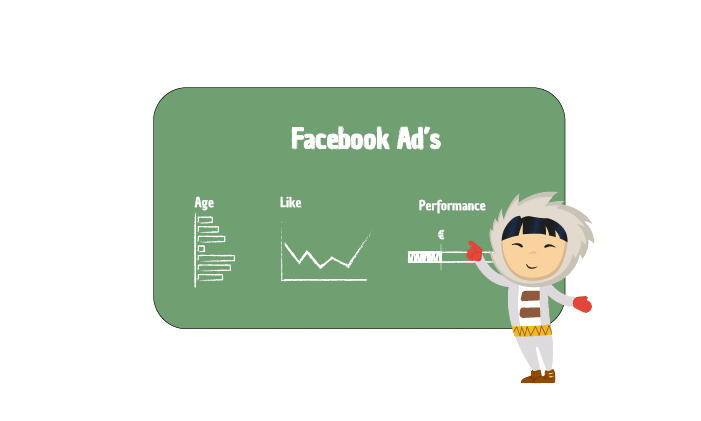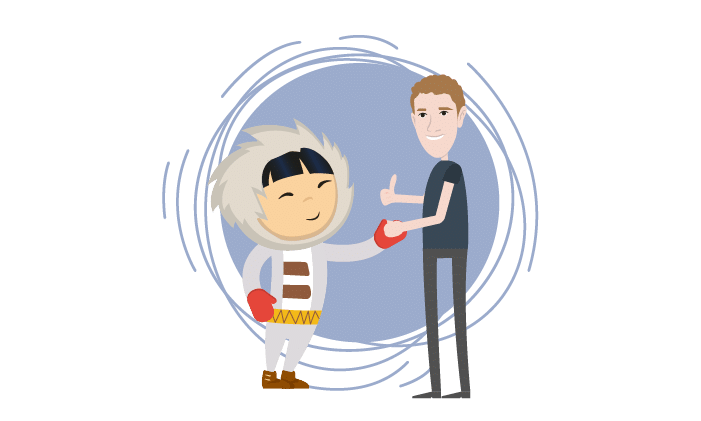In just a few years, social advertising has become a major element to leverage for customer acquisition. It turns out to be one of the most effective paid channels in terms of lead generation and client conversion. This explains why the global budget allocated to social media advertising is set to double in the next five years (CMO survey).
Falling under this category, Facebook Advertising dominates the market. 96% of marketing experts specialising in social media see Facebook as the most ROI-orientated platform (eMarketer survey). This makes sense: Paid campaigns are especially efficient there, and B2B performs just as well as B2C.
Yet, because Facebook Ads have been in the picture for quite some time now, you’re probably wondering if you may not be a bit late to the party. If there are even any opportunities left out there for Facebook ads. The answer is a resounding yes! Facebook’s growth is exponential, both in terms of users and markets, which means you have all the leeway you need to jump on the bandwagon and take full (paid) advantage of Zuckerberg’s network.
So long as you know how to build on good practice. Here is a comprehensive Facebook Ads Guide to help you learn how Facebook Ads work and how to make the most of them.
What are Facebook Ads?
The expression “Facebook Ads” describes the advertising programme provided by the social media platform Facebook for businesses who wish to communicate there. It is the exact equivalent to Google’s AdWords.

Facebook Ads are none other than adverts posted on Facebook and on its partnering websites (and applications). This solution allows advertisers to benefit from the huge influence of the world’s most popular social media network, where users flock to throughout the day (when they wake up, during their commute, at work, while watching TV…) and from any device (computer, smartphone, or tablet).
To this, one must add the perks specific to this advertising system, which favours relevant, high-quality ads and targets the exact people that the advertiser wants to reach.
Facebook Ads arrived on the platform (which is free to subscribe to and use) in 2007, bringing monetisation to the table.
Why advertise on Facebook?
Ads on Facebook are the most effective way to reach a wide audience on the world’s prime social media network. As you probably know, the organic impact of traditional content has been wearing thin. “Reach” took another big hit when Facebook updated its algorithm at the beginning of 2018. At that pace, no one knows what it will be like one, two, five years from now. Or whether organic reach won’t have simply disappeared at one point or another.

That’s why many businesses would rather turn to paid acquisition, which is always more effective thanks to how Facebook’s advertising mechanism is evolving. If you know how to create Facebook Ads and make the most out of targeting, creating customised target audiences, Audience Network, or the various types of campaigns, it is possible to make a substantial profit.
And it does work: In 2017, 5 million businesses launched at least one Facebook Ads campaign, and this figure almost doubled the following year (whereas there were only 3 million in 2016). According to Forbes, the actual number even reaches 6 million (read the article here).
Facebook Ads: The Best Practices
Facebook Ads are so easy to set up that anyone could launch their own campaign very quickly, and without having to rely on a huge budget. But this doesn’t mean that you won’t make a good return on investment. To help you see further than merely launching an ad, here are a few tips that will boost your Facebook Ads campaign.
DEFINE A CLEAR TARGET
Any Facebook Ads campaign begins with precise targeting. Start by clearly defining the people you want to reach and make sure to consider as many criteria as possible.
Then, section out your campaigns. This is a crucial step which will lead you to personalise the messages you wish to extend to the different categories of audiences that you are targeting. If you send the same exact ad to all your segments, then the risk is to offer a standardised, impersonal message that won’t really speak to anyone, or that will send unqualified prospects your way. Targeted ads, on the other hand, are designed for a specific audience. Though it won’t generate as many visitors, they will all be much more qualified, and therefore likely won’t require as much effort (and money!) to be turned into customers.
BUILD THE RIGHT KIND OF ADVERTISING
Facebook Ads all have more or less the same format. They are made up of a tagline (the written introduction just above the image or video), a visual, a title (which appears below the visual), a description (under the title), a link (below the description), and a CTA (on the right-hand side of the link).
You need to make sure that all these elements are there and optimised.
INCLUDE VISUALS IN YOUR ADS
Creating a visual ad is vital. Visual content is favoured by Facebook’s algorithm, which means it’s much more likely to appear higher on the user’s feed. Above all, an image is easier to memorise – and to share – than written content, not least because it takes no time to look at, whereas reading text can be time-consuming.
We might even go as far as to say that, regardless of the quality of your advert, an attractive image is all you need to capture the users’ attention.
SELECT THE RIGHT BILLING MODEL
Facebook allows you to choose how you want to be billed for your adverts: CPC (cost per click), or CPM (cost per thousand impressions). With the first model, you are charged every time a user clicks on your ad: this is pay-for-performance advertising. With the second one, you pay once your advert has been displayed a thousand times: you pay for visibility. The former is cheaper than the latter.
Choose the model that best matches your needs in terms of profit. Let’s say you are willing to spend €50 on Facebook Advertising, and CPC is €5, against €10 for CPM. Your budget could get you either 10 clicks, or 5,000 impressions. This means a CPM campaign will become interesting if your click-through rate is higher than a certain level, here, 0.2% (number of clicks allowed for your budget divided by the number of impressions allowed).
If your aim is to maximise your click-through rate, then CPM will be more relevant.
OPTIMISE YOUR RELEVANCE SCORE
Just as Google does, Facebook likes ads that provide its users with added value. If they’re going to be disturbed during their daily scrolling, it might as well be by ads that could fit their needs. To that end, the network implemented a “relevance score” similar to the AdRank that can be found with AdWords, which influences the way Facebook treats adverts in terms of visibility.
Therefore, the idea is to get the highest relevance score possible by creating Facebook Advs campaigns that are targeted well enough to satisfy the users and make them want to click on your links.
OFFER A REAL VALUE PROPOSITION
The value proposition of your Facebook Ads makes all the difference between an ad people want to click on, and one they just want to ignore. Users are neither naïve nor easily deceived. Claiming that you are “the best service provider in your category” won’t be enough to get them on board. Conversely, a special offer, voucher, verified figures, free demonstration – are just as many incentives for your targets to pay attention to.
Just don’t forget to include a call to action; otherwise, all your efforts will have been in vain.
SELECT THE RIGHT ADVERTISING PLACEMENTS
You are free to choose where your ads will appear on the user’s Facebook page.

- In the right-hand column. This is the most traditional ad format, just at the right of the feed. This placement is the most worthwhile for CPC. A clear value proposition, just the right CTA, relevant content and an attractive visual make this type of Facebook Ads as effective as it gets.
- Within the feed. This is the most efficient spot, as ads show up right inside the users’ feeds, where they can capture their attention. Because these have a lot in common with traditional advertising, they tend to be seen as less intrusive – which increases the potential click-through rate.
One thing to keep in mind is that this placement is subject to a very high relevance score. Note that it is available both on the mobile and desktop version of the platform.
- In Instant Articles. These adverts show up in the instant articles on the Facebook and Messenger mobile apps.
- In the integrated or suggested videos. Facebook Ads in the form of videos can appear in two different places: inside Live and on-demand videos, or between the images and videos suggested by the social network.
- On the Marketplace. Especially useful for retail websites, these adverts show up on the Facebook Marketplace (on the mobile app’s home page or while users are browsing).
Your Facebook Ads can also appear in places outside Facebook itself. This is referred to as ad placement. This option lets you advertise on Instagram (in users’ feeds or in their Stories), on Messenger (on the home tab, or in the form of sponsored messages), or on a number of websites and mobile applications from the Audience Network (as banners, native advertising, or interstitial ads).
Note that Facebook applies the “automated placement” option by default. With that said, you can always select which placements you want to prioritise, particularly if you want to delete the ones that have not been working well (after several days of campaign). Here’s an example: since the Audience Network is the placement that offers the lowest CPC, Facebook tends to make it the main advertising solution. The issue, however, is that this placement often doesn’t provide the best return on investment. So, you could choose to eliminate it after a few attempts if it’s not suitable for you.
USE CUSTOM AUDIENCES
Custom Audiences allow you to target people who know (or are already in contact with) your business on the network. From a variety of sources (your own list of customers, engagement, traffic on your own website, on the mobile app, on Facebook, etc.), you can create a custom audience that you can then target very specifically through Facebook Ads.
The better targeted your ads are, the higher your chances of reaching the right people, and the more likely they are to click on your links. This improves your click-through rate, which, in turn, makes your adverts more relevant, etc.
From a custom audience, you can also create lookalike audiences, which is to say audiences closely similar to the people who are already in touch with you on the network. This option is guaranteed to target your audience even more effectively. Based on a number of criteria, you get to send your messages or offers to users who, because their profile is very close to those of your existing customers’ (for instance), could be converted more easily. This is a great way to increase your brand awareness and drive traffic to your website.
CHOOSE YOUR TYPE OF ADVERT
One of Facebook Advertising’s greatest strengths is the variety of publishing formats it has to offer. Technically, you could do just about anything your heart desires. Here are a few examples that we find to be especially relevant:
- Sponsored posts (organic content that already exists and is pushed forward through advertising).
- Photo advertising (perfect to entice users through attractive visuals).
- Video Ads (which appeal to the users more and more: over 8 million videos are watched on the platform every day – reference).
- Multi-product adverts, in the form of a carousel (to introduce several products, services, or posts in the same ad, with the ability for users to click on individual links).
- Local targeted adverts (to direct your prospects to your physical store in a given area).
- Offers (ads focused on special offers and valid on Facebook only).
- Retargeting adverts (which “follow” identified users throughout their journey on the web). These work with the Audience Network.
- Ad hoc publicity (to promote a specific event).
- Dynamic ads (inspired by Google Shopping, these display the most relevant service or product based on the user who views them).
- Mobile app adverts (which send the users directly to the store, where they can download the app mentioned in the ad).
Note that each one of these ad formats can benefit from custom audience targeting.
MEASURE THE PERFORMANCE OF YOUR FACEBOOK ADS CAMPAIGNS
Creating an ad on Facebook is one thing. But it’s only a starting point. From there, you could (and should) measure how effective your campaigns are to make sure that they are reaching their objectives all while remaining within your budgetary constraints, meaning with a positive return on investment. You could measure your click-through rate, conversion rate, cost per conversion, etc.

Measuring the performance of your adverts allows you to modify them instantly and make them more effective if need be. Facebook put two tools at your disposal: the Facebook Ads Manager (which also comes as a mobile app), and the Business Manager.
Facebook Pixel (a piece of code you can insert on your website) also helps you keep track of conversions.
PERFORM A/B TESTS
It is impossible to improve your Facebook Ads without testing them regularly. Widely used in web marketing, A/B testing is essential if you want to assess the most effective combinations and check whether such or such version of your ad performs better than another with X or Y target.
GET RIGHT TO THE POINT
Never forget that you are on a social media network and that the users’ attention span doesn’t exceed a few seconds. Just a quick glance will be enough for someone to form an opinion on the value of your ad. This means that you have to get straight to the point: write a short, clear, and relevant message. Also keep in mind that most people browse Facebook from a mobile device. You need to make certain that your message will be displayed properly and in its entirety.
CULTIVATE GREAT LANDING PAGES
A user clicking on your ad is only the very first step. You might think that the most difficult part is behind you, but it couldn’t be further from the truth. Now the whole purchasing experience has to deliver on your value proposition. Picture a shampoo ad that would send the users to a page about flat-screen TVs! That’s exactly why you have to put so much care in your landing pages, so that the users who clicked on your ads find everything they were hoping for.
Now, you’re all set to start your own Facebook Ads campaign!











